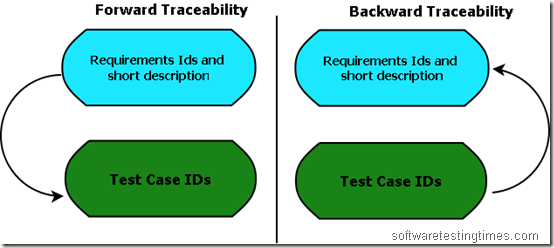This document is prepared to make the clients satisfy that the coverage done is complete as end to end, this document consists of Requirement/Base line doc Ref No., Test case/Condition, and Defects/Bug id. Using this document the person can track the Requirement based on the Defect id
Note – We can make it a “Test case Coverage checklist” document by adding few more columns. We will discuss in later posts
Types of Traceability Matrix:
- Forward Traceability – Mapping of Requirements to Test cases
- Backward Traceability – Mapping of Test Cases to Requirements
- Bi-Directional Traceability - A Good Traceability matrix is the References from test cases to basis documentation and vice versa.

Why Bi-Directional Traceability is required?
Bi-Directional Traceability contains both Forward & Backward Traceability. Through Backward Traceability Matrix, we can see that test cases are mapped with which requirements.
This will help us in identifying if there are test cases that do not trace to any coverage item— in which case the test case is not required and should be removed (or maybe a specification like a requirement or two should be added!). This “backward” Traceability is also very helpful if you want to identify that a particular test case is covering how many requirements?
Through Forward Traceability – we can check that requirements are covered in which test cases? Whether is the requirements are coved in the test cases or not?
Forward Traceability Matrix ensures – We are building the Right Product.Traceability matrix is the answer of the following questions of any Software Project:
Backward Traceability Matrix ensures – We the Building the Product Right.
- How is it feasible to ensure, for each phase of the SDLC, that I have correctly accounted for all the customer’s needs?
- How can I certify that the final software product meets the customer’s needs? Now we can only make sure requirements are captured in the test cases by traceability matrix.
No traceability or Incomplete Traceability Results into:
1. Poor or unknown test coverage, more defects found in production
2. It will lead to miss some bugs in earlier test cycles which may arise in later test cycles. Then a lot of discussions arguments with other teams and managers before release.
3. Difficult project planning and tracking, misunderstandings between different teams over project dependencies, delays, etc
Benefits of using Traceability Matrix
- Make obvious to the client that the software is being developed as per the requirements.
- To make sure that all requirements included in the test cases
- To make sure that developers are not creating features that no one has requested
- Easy to identify the missing functionalities.
- If there is a change request for a requirement, then we can easily find out which test cases need to update.
- The completed system may have “Extra” functionality that may have not been specified in the design specification, resulting in wastage of manpower, time and effort.
Thanks for very good info!
ReplyDeleteProduct Traceability Software